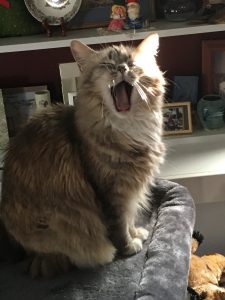 Having a kitten in the house—well, now I guess Olivia’s considered an adolescent—I’ve become interested in the sounds they make. Olivia is six months old and she still uses her squeaky kitten sounds sometimes with me, but I also notice a more mature cat mew and meow and prrrt more often. She does make some cute sounds.
Having a kitten in the house—well, now I guess Olivia’s considered an adolescent—I’ve become interested in the sounds they make. Olivia is six months old and she still uses her squeaky kitten sounds sometimes with me, but I also notice a more mature cat mew and meow and prrrt more often. She does make some cute sounds.
Have you noticed that no two cats necessarily sound  alike? If you have more than one cat, you can usually tell which one’s coming down the hallway yowling. In some cases, only one of your cats typically does it, so you know which one it is. But you’ll also notice that Buster has a different meow sound than Fluffy, or not. If they’re the same breed, they probably have similar sounds. We had a Himalayan from a kitten mill in Missouri and she had the most southern-sounding drawl of a meow—low and lingering.
alike? If you have more than one cat, you can usually tell which one’s coming down the hallway yowling. In some cases, only one of your cats typically does it, so you know which one it is. But you’ll also notice that Buster has a different meow sound than Fluffy, or not. If they’re the same breed, they probably have similar sounds. We had a Himalayan from a kitten mill in Missouri and she had the most southern-sounding drawl of a meow—low and lingering.
 My daughters, when they were little girls, were fascinated by the fact that I understood what the cats wanted when they’d meow or otherwise address me. Yeah, because cats use body language along with any vocalizing they might do. Cats speak with their tone, body language, eyes, posture, and facial expressions. All we have to do is “listen.”
My daughters, when they were little girls, were fascinated by the fact that I understood what the cats wanted when they’d meow or otherwise address me. Yeah, because cats use body language along with any vocalizing they might do. Cats speak with their tone, body language, eyes, posture, and facial expressions. All we have to do is “listen.”
But what about the purr? What does it mean? You’ve probably heard/felt your cat purr when she’s in a situation where she’s not happy. On the veterinarian’s table, for example. Cats purr when they are contented, but they also purr when they’re under stress or frightened. It’s their way of helping to calm and comfort themselves.
If you don’t think your cat has anything to say, you haven’t been listening to him and observing. Check out this interesting site, then go have a meaningful conversation with your favorite cat.





